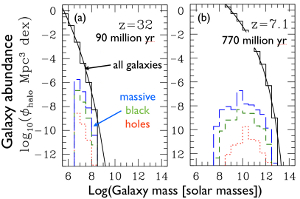|
|  |
A supermassive black hole with a mass several million or even billion
times the mass of the Sun lies at the centre of every massive
galaxy. Observations of quasars — supermassive black holes in
luminous, gas-eating states — show that they must have formed at
around the same time as the first stars and galaxies, during the first
few hundred million years after the Big Bang. The origin of these
gravitational monsters remains one of the major unsolved problems in
astrophysics (see  Research Highlight July 2012). Research Highlight July 2012).
The first stars and galaxies formed more than 13 billion years ago,
when the mixture of primordial gas (mostly hydrogen and helium) and
dark matter in the early Universe started to build up in dense
pockets. There, the gas formed hydrogen molecules, and collapsed due
to its own gravity to form the first stars.
Astrophysicists believe that the first super-sized black holes formed
shortly afterwards, by one of two possible processes. The first
possibility is that massive stars left behind black holes when they
ran out of fuel. These then consumed matter from their surroundings
and fused together with each other until they became supermassive. The
second possibility is that extra-massive black holes formed from the
direct collapse of very massive clumps of hot gas (about 8000 Kelvin,
hotter than the surface of the Sun) that did not form hydrogen
molecules — gas without hydrogen molecules would not have collapsed
into ordinary stars, but instead much more massive objects.
As mentioned above, galaxies formed from — and consist of — a mixture
of dark and ordinary matter. While ordinary matter is made of the
familiar protons, electrons and neutrons, the dark matter interacts
with normal, atomic matter only gravitationally. Actually, most of the
mass inside a galaxy is in the form of this mysterious component. In a
typical galaxy today, the union of the two types of matter — ordinary
and dark — is peaceful, but this was not the case at the time when the
first stars and galaxies formed.
Recent studies have shown that in the early Universe, ordinary matter
and dark matter did not move in unison — much as fish do not always
swim with the current of water. Because of the fact that there were
relative motions between ordinary and dark matter — that they
“streamed” against each other — they cannot have gravitationally
collapsed in the same way. The dark matter, being more abundant,
collapsed first, and gravity pulled in the ordinary matter only after
the motions had slowed down. This means that because of the primordial
streaming motions, the first stars and galaxies formed somewhat later
than previously thought (Figure 2).
Recently, a collaboration between scientists at the Max Planck
Institute of Astrophysics and the Columbia University (New York, USA)
investigated the effects of these streaming motions on the formation
of the first supermassive black holes.
As stated above, one of the main effects of the streaming between two
kinds of matter is that stars form later than previously believed. If
monster black holes are descended from these first stars, then their
rise in the Universe would also be delayed. Future telescopes such as
the planned James Webb Space Telescope by NASA might be able to detect
black holes at these early epochs, some 400 to 500 million years after
the Big Bang. Models including streaming motions would predict as much
as 10 times fewer massive black holes than previously expected.
A second study found that in rare cases, primordial streaming motions
could also help to make extra-large black holes directly. Such events
could occur in rare places in the Universe where the streaming is
especially vigorous, and also where large amounts of dark matter begin
to accumulate exceptionally early.
Under such conditions, large pockets of gas hotter than 8000 Kelvin can
assemble before ever forming hydrogen molecules
and stars, and therefore collapse into massive black holes much
earlier than previously thought (Figure 3).
It is uncertain how often this rare combination of conditions actually
resulted in the formation of massive black holes. However, as it turns out,
this mechanism could explain the abundance of the most luminous quasars
observed when the Universe was 800 million to 1 billion years old —
regardless of whether extreme streaming motions successfully formed massive
black holes less than 1 per cent or nearly 100 per cent of the time.
These studies reveal that primordial motions between ordinary mater
and dark matter influence both scenarios proposed for the formation of
supermassive black holes. These new insights could give valuable clues
for the interpretation of future observations of the universe at early
epochs.
Takamitsu Tanaka, Miao Li and Zoltán Haiman
References:
Takamitsu Tanaka, Miao Li & Zoltán Haiman,
“The effect of baryonic streaming motions on the formation of the
first supermassive black holes”,
2013, MNRAS, 435, 3559
Takamitsu Tanaka & Miao Li,
"The formation of massive black holes in
z~30 dark matter haloes with large baryonic streaming velocities",
2014, MNRAS, in press.
|


